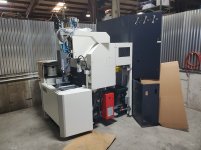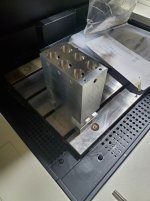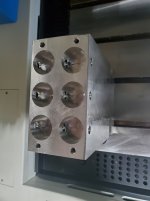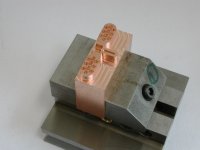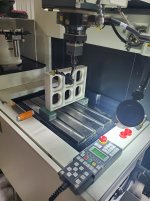Hi again BOB-OO:
Your evolving description of what you're trying to do is beginning to really take us into the weeds, but I think it's a worthwhile conversation to have.
So let me try to organize your problem with respect to the EDM strategy and forgive me if there is something I'm not understanding correctly or assuming wrongly.
First, your description of how you wish to mount the trode blanks suggests you are unaware of just how quickly the trodes will wear and what a PITA it's going to be to change them when they do.
You want something quick and secure...you do not need accurate but you do need rigid.
So a plate with ER collet holders if your trode blanks are round is nice because it's so convenient to change out and it's forgiving if the raw graphite stock is not consistent in diameter (it's often not!).
You are going to rely on the precision of the Kitamura to make all of the trodes spaced the proper known distance apart, and you will rely on the Kitamura to make each trode the proper shape.
But you don't KNOW that it can do that, after it warms up and the cutters wear and etc etc.
Traditionally, the way around that is to edge touch each electrode to each workpiece blank and establish their correct relationship...Makino can write you a routine to do that automatically, but there are things you must do too.
Principal of these is to space the parts and the trodes far enough apart that you can actually do the edge touches without crashing one of the other trodes into one of the other workpieces or making a touch on the wrong trode that you thought was on the correct trode.
The obvious way is to make the pitch of the trodes a twitch bigger than the pitch of the workpieces so you know you're touching the right trode to the right workpiece.
This is a fundamental constraint whenever you try to burn a gang trode into a gang workpiece setup and must have better precision than the crude setup shown in my last post.
Now it IS possible to try to make the workpiece setup and the milling of the gang trodes so damn accurate that you can just assume they are all in proper position and the trodes are all identical, but when it's tenths you care about, that's almost impossible to achieve.
Since you have a toolchanger, you can make individual trodes in individual holders and circumvent all that bullshit: basically losing nothing but the toolchange time and the edge touch time which is truly trivial compared to the burn time.
So long as your workpiece spacing is far enough apart to allow trode to workpiece edge touches you will be able to position your trodes to the best precision the machine is capable of, even when you have a gang workpiece setup and you don't know exactly where each workpiece is sitting in the fixture.
The details of how to wash down the workpieces prior to those touches, how to ignore a false touch, how to calculate the origin from those touches, I leave to your Makino Application guys.
They've probably solved this set of problems a bazillion times already, and will be able to advise you better than I can.
Now understand that this is only for the FINISH burns...I still recommend a gang trode for the roughing burn...it will go faster and you don't need exquisite precision to knock out most of the meat before you semifinish and finish burn.
Moving on to workpiece clamping...if you commit to the edge touching for all finish burns you also don't care that much that the workpiece clamping be dead nuts accurate in terms of spacing.
It still needs to be decent if you gang rough, but it doesn't need to be dead nuts.
That frees you to concentrate on the other things it does need to be.
You need to clamp each workpiece dead nuts square and oriented properly to any other features the part may have that were put in prior to the burns.
That's just basic fixture design and I leave that to you.
But the other thing you need to care about is that pesky cleaning I talked about.
You will NEVER be able to clean it perfectly for all stations if it remains in the machine between part changes.
But the 3R clamping system is designed to be easy to clean in the machine...the crossed vees that locate the clamping plate to the receiver are super accessible and easy to inspect and there are only 8 exposed surfaces you must get right.
So take advantage of that.
Also take your cues for your fixture design from the 3R design...leave ample space where the shit can accumulate without getting onto your locating features.
Make the locating features accessible and easy to wipe down and inspect.
Make them hard and abrasion resistant...440C Stainless at 60+ RC if you want them corrosion resistant too, D-2 at 60+ RC if you don't need the corrosion resistance.
If you want to get fancy you could also have them nitrided or hard chromed.
Plan to buy yourself an ultrasonic cleaner big enough to hold a complete part fixture and make two so one can be burbling in the ultrasonic while the other is burning.
If you are willing to do all these things, I predict spectacular success.
I will remain super envious of your cool new toy.
Please don't forget to post pictures when it's successful and running.
Cheers
Marcus
www.implant-mechanix.com
www.vancouverwireedm.com





